We’re on the home stretch now! For so long the games in this rear-view mirror have been so old that it seems almost as if they were played by a different person. But now we’re up to the year 2011, which doesn’t seem like that long ago.
As I mentioned in my last post, 2011 was the year that Mike Splane started hosting his chess parties. They made a difference in my chess, but it took time for that effect to materialize. So for the most part, 2011 was a year of treading water. I played in four tournaments, 22 games total, and scored exactly 50 percent. No prizes, no memorable wins to get excited about, only a couple of draws against International Masters (John Donaldson and Ed Formanek). Unfortunately I do not have the score of the Donaldson game, because at some point I lost my binder and so the only games from 2011 that I have records of were the games I had already entered into my computer.
I do still have the score of the Formanek game, but I already wrote a very long post about it at the time. It was my first experience as the defending side in the notorious K+R+B vs. K+R endgame, which I call one of the Four Endgames of the Apocalypse. I managed to pull out a draw even though we got to the Philidor position, which is a theoretical loss. This confirmed my impression that the endgame is too hard even for IMs to play correctly with the clock ticking. At minimum, you have to stone-cold memorize the Philidor position and how to win it. I think that Formanek had a general idea of the plan but he was missing one move.
Anyway, I have nothing new to add to that post, but I do strongly urge players who want to learn that endgame to follow the link above. Instead, for today’s post I want to show you another game from the same tournament, the 2011 Western States Open, in which I defeated a player named Carl Harmon-Vellotti. He is the “other” Vellotti, just like Alan Naroditsky is the “other” Naroditsky, etc. It was Carl’s misfortune to have a younger brother, Luke, who became a national junior champion, an International Master, and a 2500-plus player, while Carl merely got to an expert rating and then retired. It must be very frustrating to be in that position. Making it to expert level in chess is a great accomplishment… but if your baby brother is an IM, it looks as if you’re somehow deficient. Hopefully, if you’re in that situation, you have parents who tell you that there are lots of other good and important things you can do with your life besides becoming a chess master.
One thing I like about this game is that I won it through pure strategy. There were no tactics to calculate until the very end. It’s also a very good illustration of a theme that I think a lot of players aren’t quite aware of: a bad bishop doesn’t stop being bad just because you manage to develop it outside your pawn chain. Even when it’s in front of the pawns, it can have limited ability to maneuver around them. In this case, we’ll see that Carl’s bad bishop gets stranded on the queenside and has no ability to switch over and defend on the kingside.
Dana Mackenzie — Carl Harmon-Vellotti, 10/23/2011
1. d4 Nf6 2. c4 e6 3. Nc3 Bb4 4. Bf4 …
An anti-Nimzo line that I was experimenting with at the time. I do not recommend it. Black has too many ways to equalize, including the line that Vellotti played in this game.
4. … O-O 5. e3 d5
My home analysis had mostly been in the sharp, tactical variation 5. … c5 6. Bd6 Ne4. Vellotti’s move is perfectly satisfactory and avoids the tactics.
6. Qb3 Bxc3+ 7. bc ...
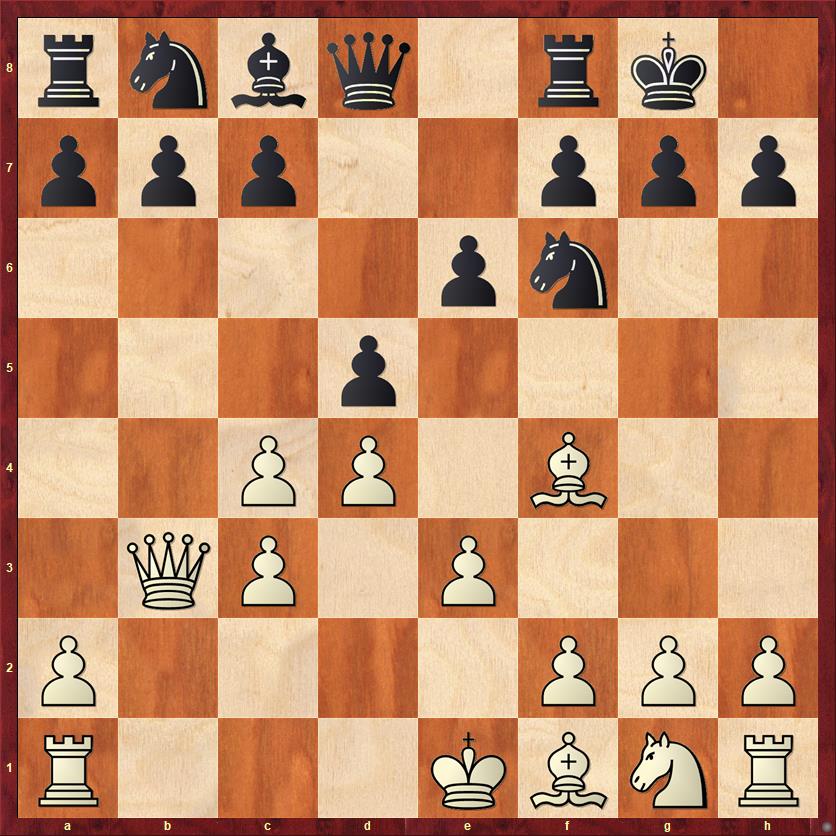
FEN: rnbq1rk1/ppp2ppp/4pn2/3p4/2PP1B2/1QP1P3/P4PPP/R3KBNR b KQ – 0 7
This may seem like a surprising decision, because I could have played 7. Qxc3 and preserved my pawn structure. But I did not like the possibility of 7. Qxc3 Ne4 8. Qc2 c5 with the threat of … Qa5+. Also, I was not too concerned about the doubled pawns because I felt that I could always exchange off one of them any time I wanted to (the front one). What I didn’t fully appreciate was that even after that happens, there is a risk that I will have a permanent weakness on c4.
7. … b6 8. Nf3 Nbd7 9. cd ed 10. Bb5 Bb7 11. Qa4? …
Chasing an illusion. I thought I was going to be able to plunk my bishop down on c6, taking advantage of his light-square weakness.
11. … a6 12. Bxd7? …
One mistake leads to another. Now, of course, I realized that 12. Bc6? would not work because of 12. … b5. But instead of just admitting that I was wrong, and maintaining the two bishops with 12. Bd3 or Be2, I felt the need to “justify” my previous wrong move by taking the knight. But this move gave away the advantage of the two bishops without receiving any compensation for it. This is a really bad thought pattern. If you make a mistake, swallow your pride and admit it.
12. … Nxd7
He could also have played 12. … Qxd7. Note that 13. Qxd7 Nxd7 14. Bxc7 does not win a pawn because of 14. … Rfc8 followed by 15. … Rxc3 with an extremely drawish position (after White plays Kd2 and Rhc1).
13. O-O Nf6
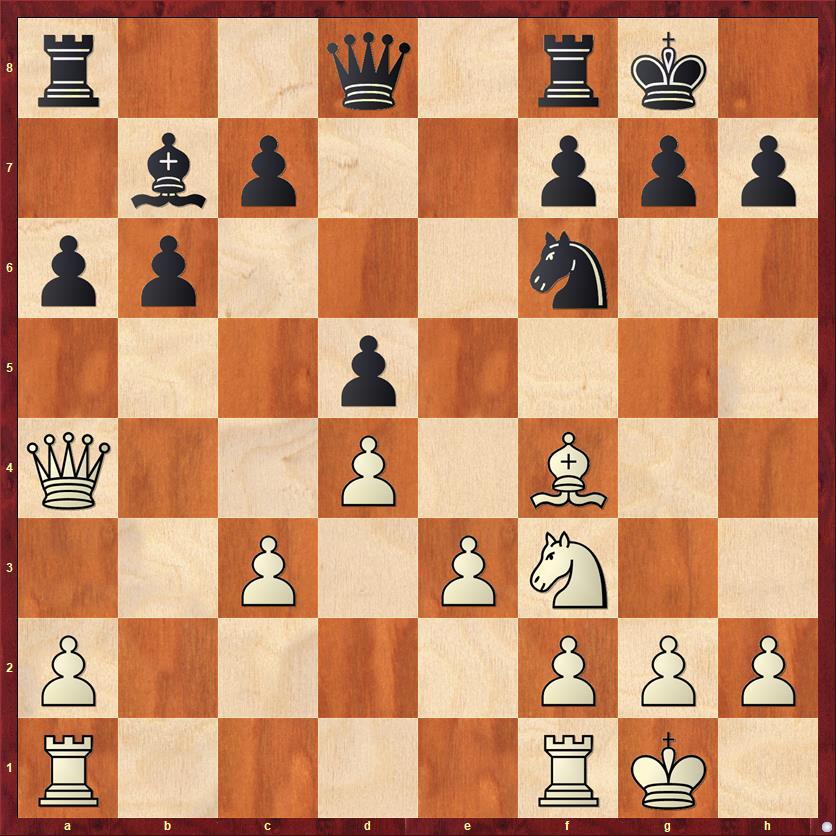
FEN: r2q1rk1/1bp2ppp/pp3n2/3p4/Q2P1B2/2P1PN2/P4PPP/R4RK1 w – – 0 14
Now comes perhaps my favorite move of the game, or at least the most distinctive move. It isn’t necessarily the best move, but I like the strategic thought that went behind it.
14. Bg5 …
Here is why I played this move. The more I looked at the position, the more I felt that Black’s knight was the strongest minor piece on the board. Both knights can come to e5 (White) or e4 (Black), but they will both be chased away by f3 (White) or f6 (Black). Black’s knight is the only one that has a suitable outpost to head to after this: it can go to d6 (or d2) and then to c4. White’s knight will not have a similar outpost.
So I decided to seize my one opportunity to remove his best minor piece from the board. One reason that bishops are better than knights is that you can give away the bishop so much more easily! That is, it is much easier to force a trade of a bishop for a knight (if you have to) when you have the bishop.
It’s interesting to contrast this bishop-for-knight trade, which was carefully considered and done for a reason, with my previous bishop-for-knight giveaway on move 12, which was done for no logical reason and gave me no positional benefit.
14. … Qd6 15. Bxf6 Qxf6 16. Ne5 …
From here on, the main strategic question to be answered in this game is: Which player has the better minor piece? Is it White’s knight or Black’s bishop? So far, the answer is neither. Black’s bishop has the potential to become a bad bishop, because the d5 pawn is in its way, but it still has plenty of ways to get out of prison. White’s knight looks nice on e5, but that is not a real outpost square, because it can be driven away by … f6.
I once recorded a lecture on this game for ChessLecture, and I talked about Jeremy Silman’s theory of imbalances here. Once you have identified the imbalances — here, the unequal minor pieces — your goal is to try to minimize the negative and accentuate the positive aspects of the imbalance. For Black, this means trying to find open diagonals for the bishop, and trying to deny White’s knight any outpost squares. For White, it means exactly the opposite: trying to create outposts for the knight and trying to hem in the bad bishop.
It is very clear why Black lost this game. He did not think in terms of imbalances, and he allowed me to accomplish exactly what I wanted to.
16. … Qd6 17. Rab1 a5 18. Rfc1 Ba6
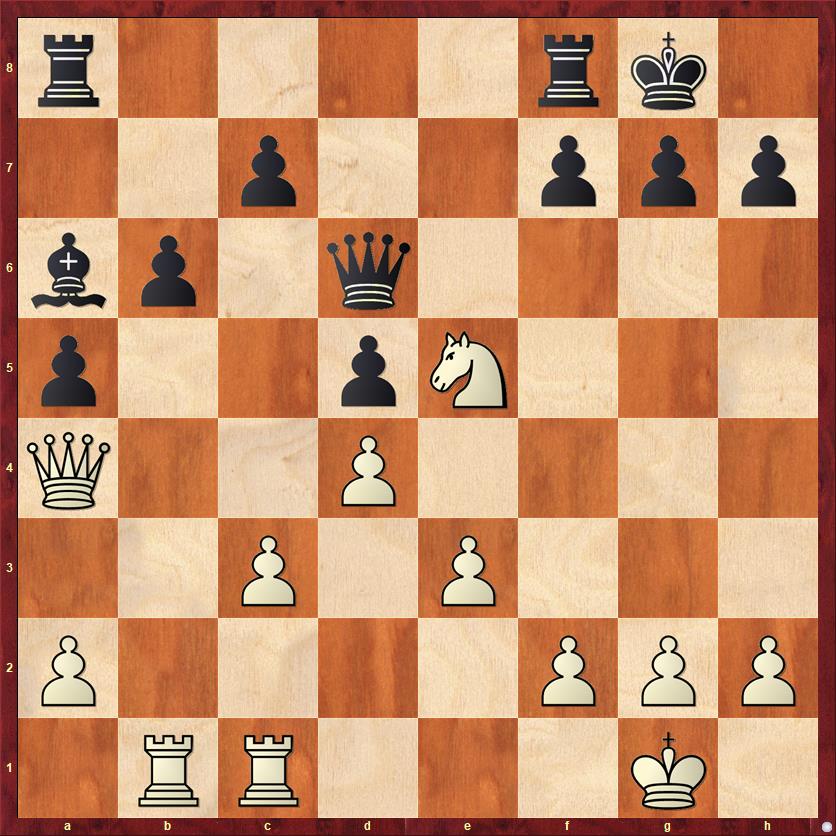
FEN: r4rk1/2p2ppp/bp1q4/p2pN3/Q2P4/2P1P3/P4PPP/1RR3K1 w – – 0 19
So far so good for Black, who has found a useful diagonal for his bishop. The next move is an important one for White, because it addresses two other imbalances. I have a backward pawn on c3 and a weak square in front of it on c4, which I would like to get rid of. And I have two rooks that would love to exert pressure on the b- and c-files and force Black’s rooks into passivity.
19. c4! …
Now is the perfect moment for this move, while the knight is still protecting c4. And it’s tactically justified by the position of Black’s queen on d6.
19. … f6
I said before that this was a game with no tactics, but I guess I wasn’t quite right. This sequence of moves is the one tactical interlude in the game. However, it should be seen as a tactical sequence that is played to achieve a positional goal.
It looks as if White may be in trouble because after his knight moves, the c4-pawn will fall. Of course I saw that, and had an answer prepared.
20. c5! …
Gaining a tempo with the counterattack against the queen. Black does not really want to take on c5, because that would give me another tempo-gaining move: 20. … bc 21. Nd7! and now if 21. … Rfd8 22. Nxc5 and the knight has found an ideal outpost square. Another possibility that had to be carefully calculated was 20. … bc 21. Nd7 cd?! 22. Nxf8 de 23. Nd7 ef+ 24. Kxf2 Qxh2, with a wild position where Black ends up with four pawns for a rook. I had to think, though, that White’s pieces are better organized and that Black’s counterplay amounts to nothing more than a desperate hope for a perpetual check. (Pretty amusing line, though — I don’t know if I have ever seen a b-pawn turn into an f-pawn over the course of four moves.)
20. … Qe6 21. Nf3 Bd3!
Black plays a tempo-gaining move of his own. The bishop has found an almost ideal square, where he looks in four directions at once. I am sure that Vellotti thought that he had taken care of his problem bishop once and for all.
22. Rb2 b5
Black is trying to keep the b- and c-files closed (or semi-closed) to minimize the power of my rooks. But notice that in so doing, he is starting to put his pawns on the color of his bishop. He may have thought that didn’t matter, because his bishop is outside the pawn chain.
23. Qd1 Bc4?!
Technically this is not a blunder yet, but if I were Black I would have fought tooth and nail to keep the bishop on the b1-h7 diagonal. If I were Black, I would have tried to play … Qf5, … c6, and … Be4, after which the problem bishop is now a great piece.
24. a3 c6
Here 24. … b4?! was a tantalizing possibility; Black sacrifices a pawn to create a dangerous passer after 25. ab a4. Strategically this is also a nice idea because it gives the bishop more air, and if the pawn can get to a2 the bishop has undoubtedly found a purpose and meaning to its life. I had to resort to the computer to figure out what is going on here. It says that White should continue 26. Nd2! a3 27. R2c2! Rfb8 28. Nxc4 dc and in this wild position the computer says that White has a significant advantage (+1 pawn) after 29. d5! when White’s d-pawn unexpectedly turns into a threat. There is definitely a possibility of a pawn race where both sides will promote.
This is the beauty of chess: in the midst of a strategic game, if Black had played 24. … b4 the position would have suddenly blown up into a wild tactical melee where precise computation is paramount. And yet Black’s decision to go this route would itself have been a strategic decision. If he feels that “normal” strategic play will not work for him, then more radical methods may be required.
Objectively, Black’s decision not to play 24. … b4 may have been correct (if he even considered the possibility). I can tell you, though, that as White it was a relief not to have to face this line.
25. Qc2 …
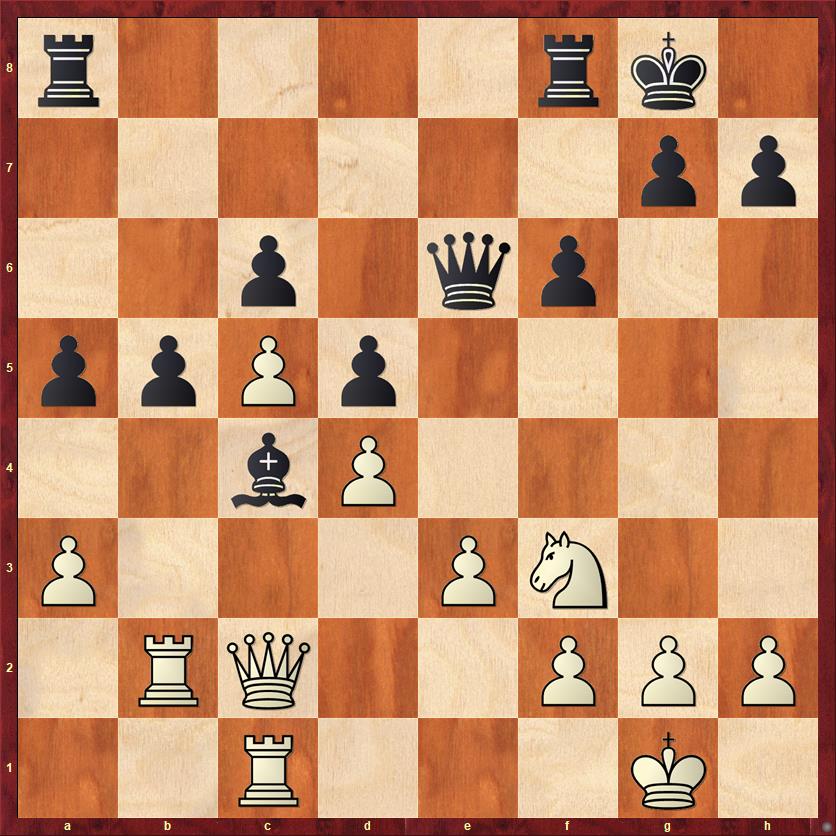
FEN: r4rk1/6pp/2p1qp2/ppPp4/2bP4/P3PN2/1RQ2PPP/2R3K1 b – – 0 25
25. … a4?!
Black continues to put all his pawns on the color of his bishop. To me, this shows that he believes it is no longer a bad bishop if it is in front of the pawn chain. That is a terrible misconception, as we will soon see. Further, we’ve just seen that … b4 is a dangerous resource that White has to be worried about. Black could try it right away with 25. … b4?! or he could try to set it up with 25. … Rfb8. By playing 25. … a4, Black reduces the threat value of … b4. (Instead of a clear and present danger, it becomes more of a nuisance in the distance.)
Finally, Black passes up an opportunity to play 25. … Qe4, which is directed toward the goal of making the bishop a more effective piece. If 26. Qxe4 de, Black now has lots of nice diagonals for his problem bishop. If White tries to decline the queen trade with 26. Qc3, Black insists on it with 26. … Qd3. Again, 27. Qxd3 Bxd3 would solve the problem of the bad bishop, which now is happy on the b1-h7 diagonal. And if White tries to prevent this with 27. Ne1, well, he gets checkmated with 27. … Qf1 mate. You saw that, right?
This line shows that Black still had sufficient resources to “cure” his ailing prelate. He just didn’t take the problem seriously enough.
26. Re1 Rfe8 27. Nd2 f5?
A second and much more serious mistake. Black’s move tells me that he is concerned primarily about the possibility that I will play e3-e4. But I wasn’t wildly enthusiastic about that idea, because after e4 Black might be able to trade on e4 and then get his bishop back to safety. More concretely, if 27. … Qf7 28. e4? Bb3 29. Nxb3 ab 30. Qxb3 de I think Black’s position is to be preferred because White’s extra pawn on the queenside is not mobile, while Black’s extra pawn in the center is. Also, that a3 pawn is a weakness. So the push e3-e4 needs to be prepared very carefully, perhaps with f3 first, but that will also give Black time to defend. Perhaps … f5 can be played after White plays f3, because then the knight can no longer come to f3 and e5.
Bottom line: Black defended against a threat that he didn’t need to worry about yet, and in so doing he fatally compromised his position.
28. Nf3! Bb3 29. Qc3 Qf6 30. Ne5 …
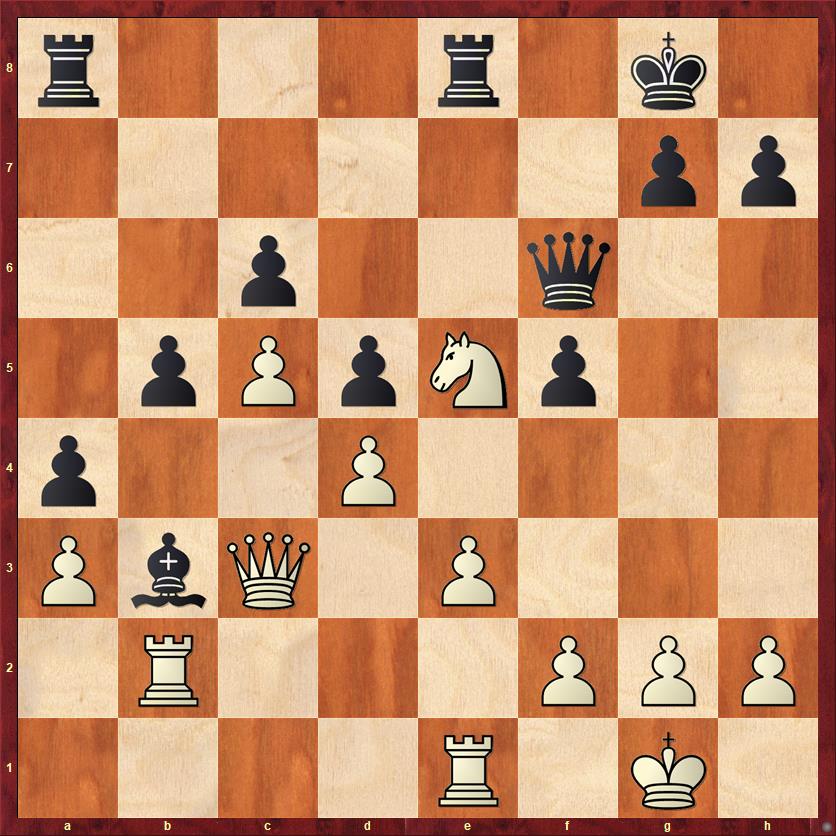
FEN: r3r1k1/6pp/2p2q2/1pPpNp2/p2P4/PbQ1P3/1R3PPP/4R1K1 b – – 0 30
Compare this position to the one after move 16! White has now won the battle of the minor pieces. My knight has a permanent, unassailable outpost on e5. It’s true that Black’s bishop also has a permanent outpost on b3, but from that outpost it makes no threats.
It’s interesting to see Fritz’s evaluation of this position, which starts around +0.5 for White and gradually goes up to +0.8 or so after five minutes and would probably continue to go up. For me, as a human, this position is simply positionally won for White. The reason is that Black has no way ever to bring his bishop to the kingside. Therefore, on the kingside I am simply a piece up.
A new idea that Mike Splane likes to talk about is the “critical zone” of the board. The player with more material in the critical zone has the advantage, even if he’s behind in material overall. The meaning of “critical zone” is perhaps a little bit unclear. It can, for example, be a color complex. Perhaps I would define it as a region of the board where one player can bring about a tactical confrontation and the other player cannot prevent it. Often (though not always) it is where the kings are. In any case, if one player can force a tactical confrontation in a region where he has the material advantage, that is often enough to win the game.
It’s interesting that until now the critical zone of this game has really been the queenside. But now that the position has crystallized in such a way that I can create a material advantage on the kingside, all I have to do is swing my pieces over there and I should be able to win!
That basically sums up the rest of the game.
30. … Re6 31. f3 Rd8 32. g3 Bc4 33. h4 …
Opening up the second rank for my rook.
33. … Re8 34. Rh2 g6 35. Kf2 Rg7
Vellotti is doing a good job of moving his pieces to the critical zone, too. The problem is that one of his pieces can’t get there, no way, no how.
36. Rg1 h6(?)
The computer says that 36. … h5 is better, and of course it’s right. White is clearly building up toward g3-g4, and Black should try to oppose that plan. On the other hand, I still continue to think that White’s position should be strategically won, and I just need to be a little bit patient. After 36. … h5 I obviously don’t want to play g4 right away, and I should get my king out of the critical zone with 37. Ke1. In fact, I can walk the king all the way to a1 if I feel like it (though I don’t think I have to go that far). Eventually I will play g4 — Black can’t stop it forever.
37. g4 g5
If 37. … fg 38. Nxg4, the pawn on h6 drops, making White’s job easier. That’s one reason that 36. … h6 was not such a good move.
Of course, 37. … g5 just made things worse, but Vellotti was in time trouble. When you’re in time trouble, staring at a busted position, it is easy to get impatient, and try to lash out and create complications. In this case, the complications are over almost before they even start, because of the power of White’s “extra piece,” the knight on e5.
38. R1h1 …
The h-file is coming open, and there is nothing Black can do to stop it.
38. … f4 39. hg Qxg5 40. Rxh6 fe+ 41. Qxe3 Black resigns
White threatens mate, and if 41. … Qxe3+ 42. Kxe3 Kf8 43. Rh8+ Rg8 44. R1h7! threatening Rf7+, Black’s position collapses.
Lessons:
- Bad bishops are still bad even if they are in front of the pawn chain.
- If you have such a bishop, be on the lookout for ways to increase its mobility, even at the cost of a pawn.
- Knights are most effective when they have outpost squares that cannot be attacked by a pawn. (See move 30 and the comment on White’s move 20.)
- Silman’s principle: Be aware of the imbalances in the position, and strive to maximize the imbalances that favor you while minimizing the imbalances that favor your opponent.
- If you have a material advantage in one region of the board and you can provoke a tactical confrontation there (the “critical zone”), you have a very good chance of coming out on top.
- It’s okay to trade a bishop for a knight. Just make sure you have a sound positional reason for doing it.



{ 3 comments… read them below or add one }
Hi Dana,
In my new chess book I describe the critical zone concept in a clearer way than my attempt to describe it at my last chess party. Here’s what I wrote:
“Critical Position In most positions the choice of move is a matter of taste, there will be several options of roughly equal value. In a critical position the outcome of the game could be decided by the next move or set of moves. This is a good time to ask the Mike Splane Question to decide which way you want the game to proceed. Once you’ve committed to one line of play in a critical position, you can’t go back to pursuing the other options that were available.
“Critical Zone The area of the board where the key struggle is taking place. In the opening it’s the center, in the middle game it can be anyplace on either side of the board. It can be a positional struggle where both sides are attempting to fix the pawn structure to make their minor pieces more effective than the opponents. But usually it involves positions where the initiative and tactics are the predominate factors.
When a king is exposed to attack, that area usually becomes a critical zone. If the king is safe, pawn structure weaknesses and target squares are usually needed before an area can become a critical zone
“Tactics are the main method used to win critical zone battles so having an extra piece affecting play in the critical zone is an advantage. Having two or more extra pieces affecting play is a very big advantage. The extra pieces don’t have to be in the zone; bishops, rooks, and queens can be posted outside the zone on open diagonals or files that include squares in the critical zone.
“Knights have to be in the zone to be dangerous, When adopting a middle game plan, their location helps you identify which sectors of the board you can turn into a critical zone.
“Advanced pawns on the fifth or sixth rank can also strongly influence play in a critical zone by taking away key squares from the defender’s pieces.
“There are three primary defensive options when your pieces are outnumbered in a critical zone. First, bring more pieces into play in the zone. Second, counterattack in the part of the board where you have the more active pieces, Third, trade off the strongest attacking pieces. This may be the best strategy when your king is in danger of getting mated. ”
Thanks for mentioning the concept in your blog.
Hi Dana.
I think that 17. …a5? is quite a severe positional error. Black has chosen a Tartakower-like setup of a QGD (Queen’s Gambit declined). The intention of this is to play …c5 and to counterplay on the queenside and if necessary or possible in the center. So 17 …a5 doesn’t fit to this setup and also causes possible weak pawns or squares on the queenside.
Of course direct 17. …c5? is impossible or loosing to 18. Qd7 and White winning the exchange or pawns. But 17. …Rfd8 is a well playable move fitting to Black’s plans and leading to an about even position .
This is an excellent point. I was wondering whether I should comment on 17. … a5 but you have just done so, better than I could have.